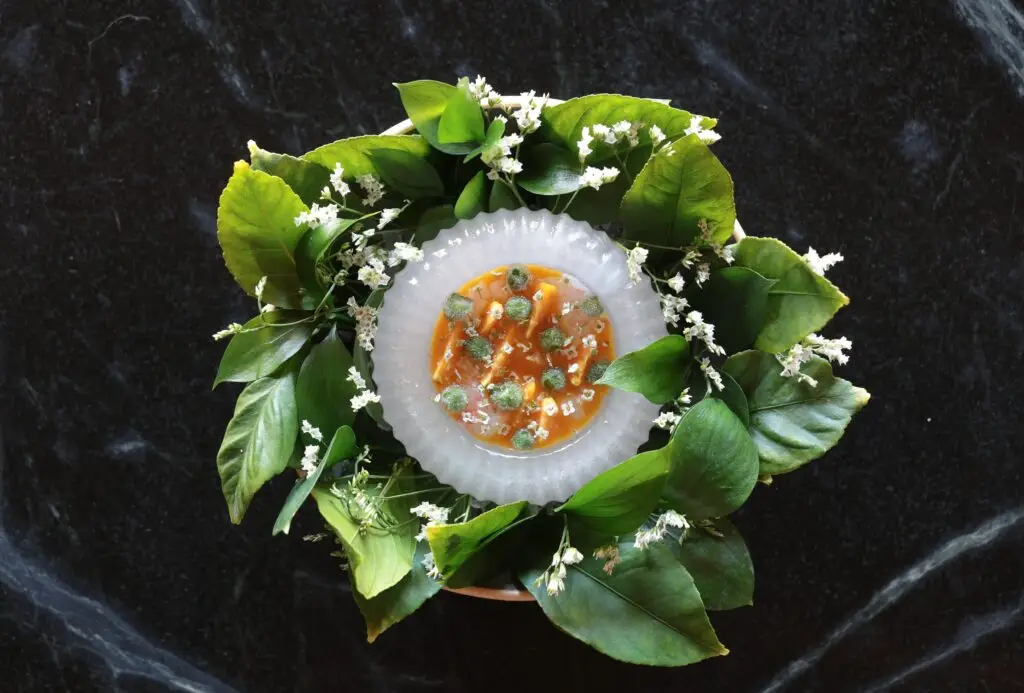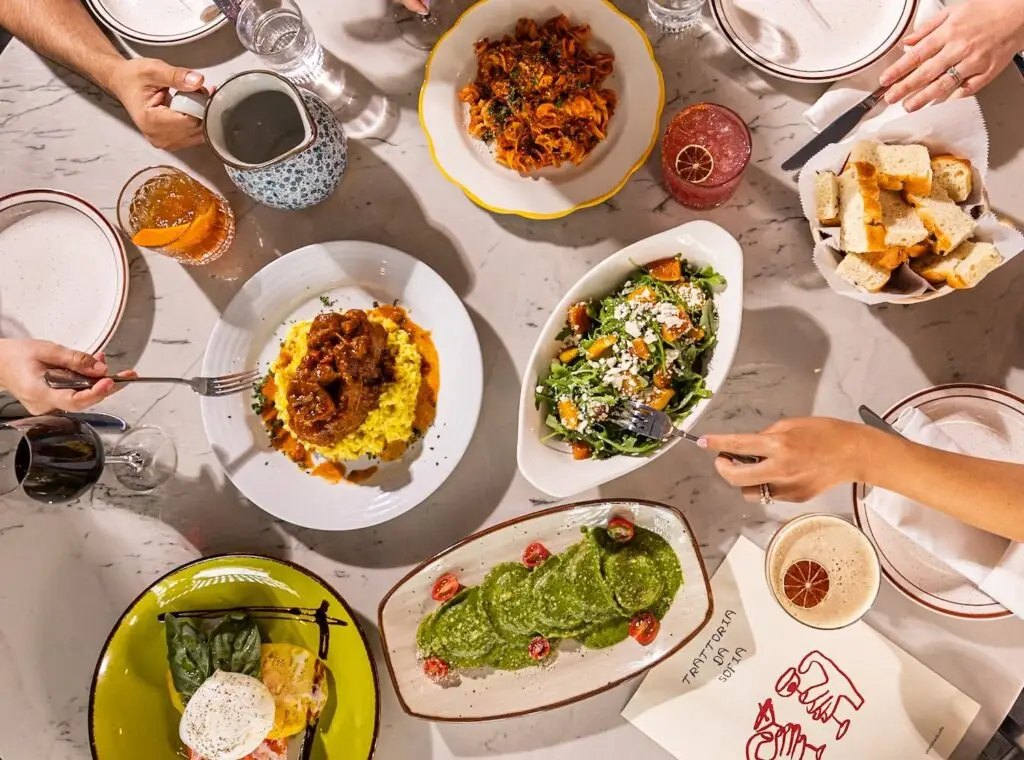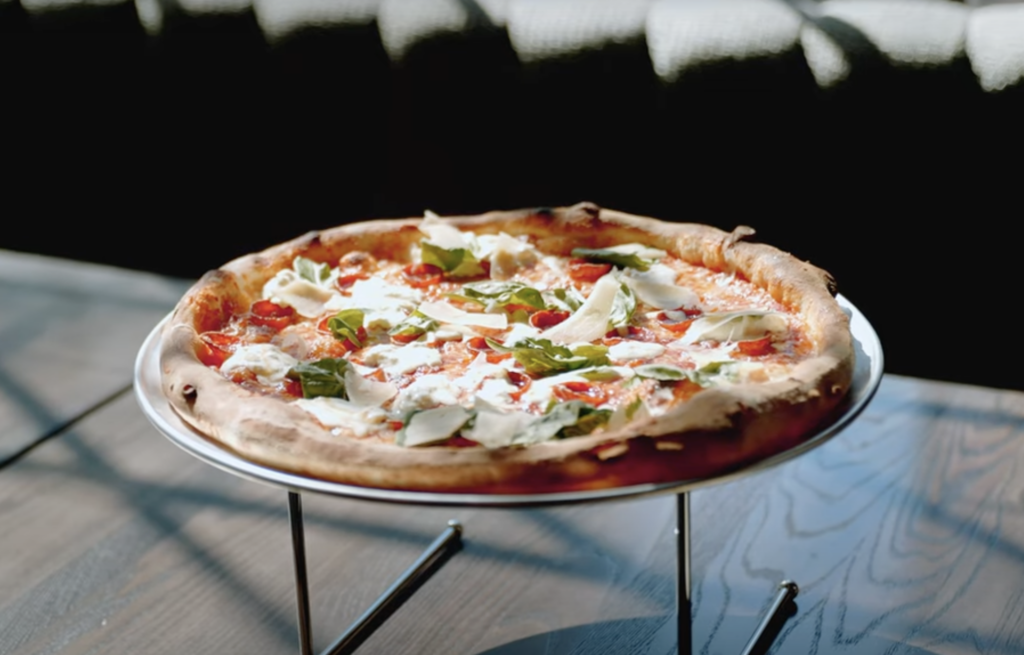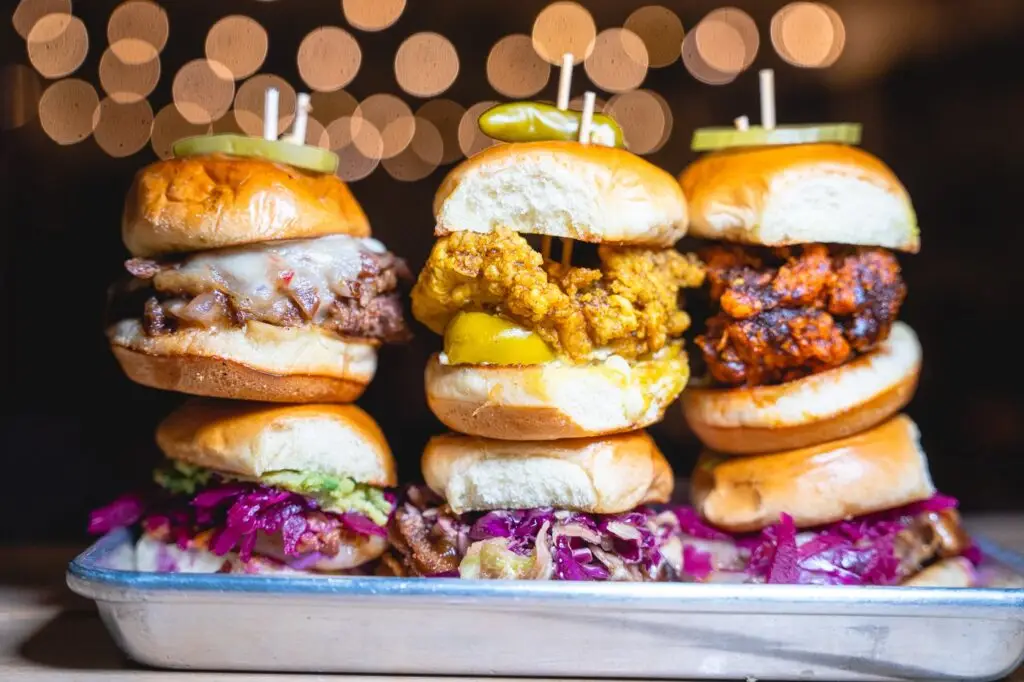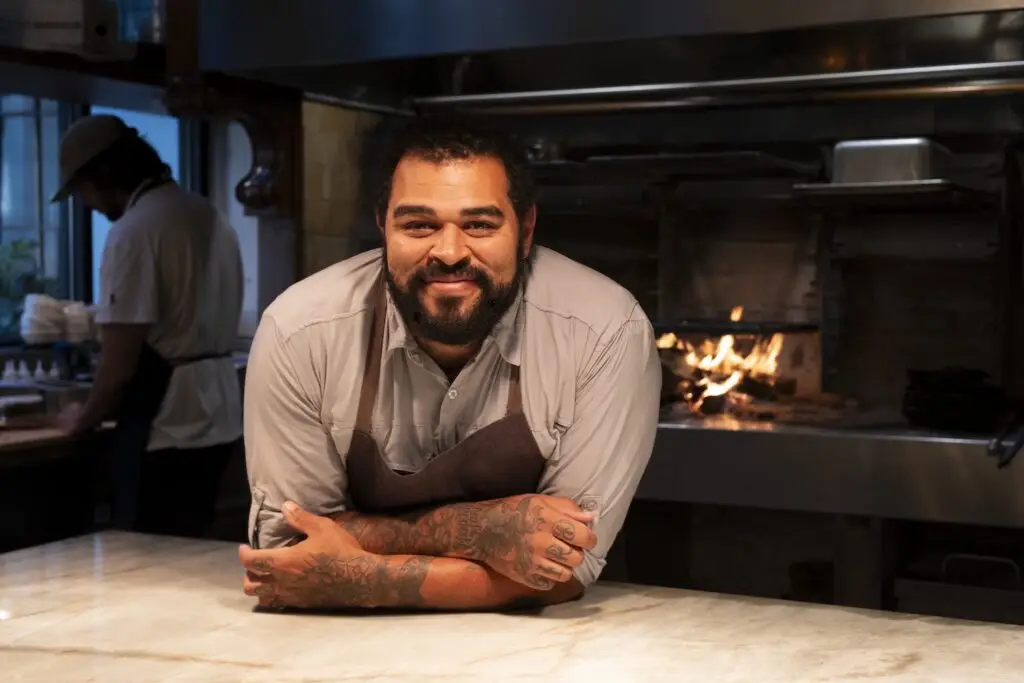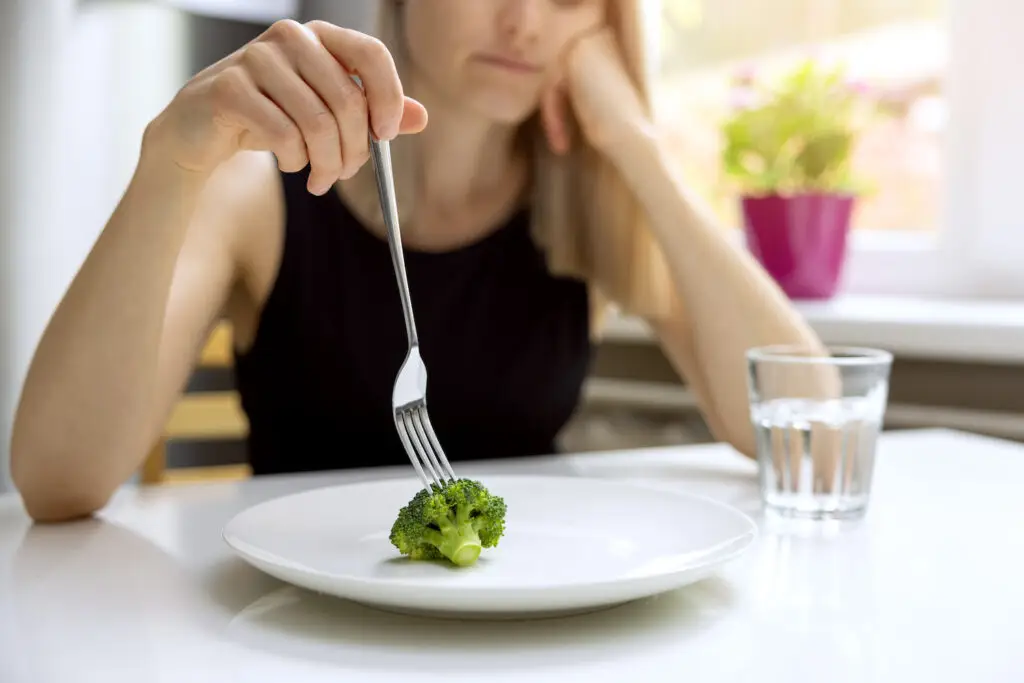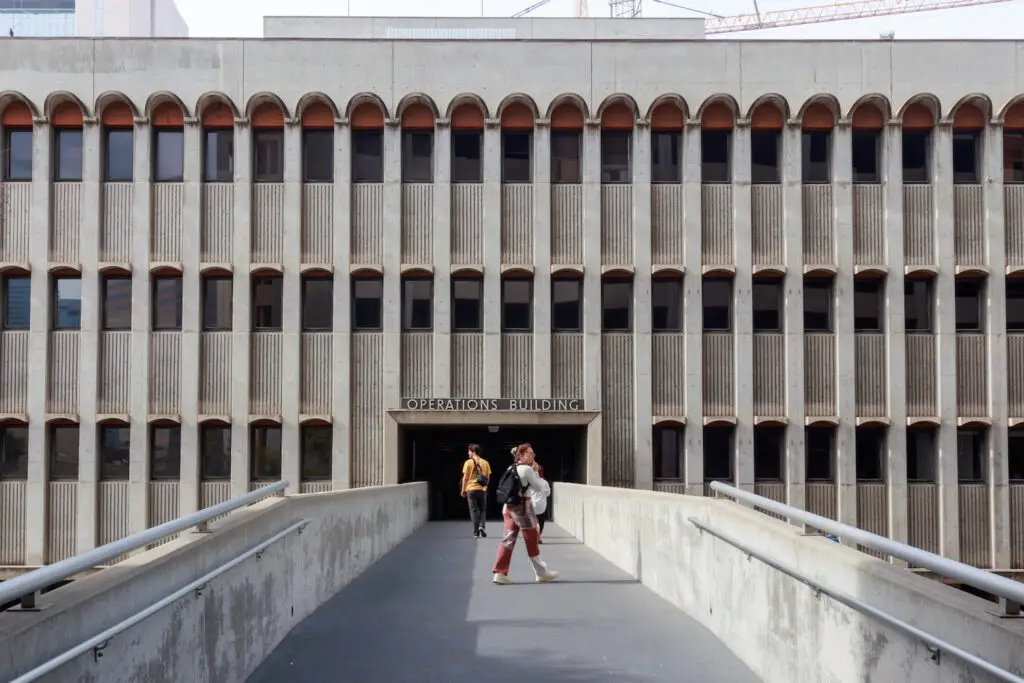A man is trying to navigate a double-wide baby stroller through the Little Italy Mercato Farmers’ Market. It’s going as expected: like a semitruck attempting to weave in and out of rush hour traffic. Jogging strollers, built wide for stability so children don’t fall out onto the sidewalk, also struggle. Compact, economy fold-ups seem the best for this experience.
The double-widers don’t seem to care. They’ve got a fresh pour-over from Bump Coffee, whose booth attendants might be models. Vista’s Hidalgo Flowers is selling lilies and hydrangeas, their display looking like Georgia O’Keeffe had a burst of inspiration and painted for days. Cute dogs sniff each other’s cute butts and play-wrestle, providing onlookers with some free serotonin. Some of the stroller moms and dads have managed to buy an apple from Escondido’s JR Organics, or that wild, alien citrus from Valley Center’s Polito Family Farms, or the beyond-red strawberries from Rodney Kawano Farms in Oceanside.
My tote bag was a freebie. I’m not even sure what it says. Looking around, I feel woefully under-toted. Many have cute designs and slogans, like “Romaine Calm” and “Your Plastic Bag Can Kiss My Canvas.” Some express the diversity of their owner’s shopping habits, like this woman whose bag reads “Walmart.”

Inside San Diego’s Big Farmers’ Market Boom
Take Me to Church
Discussing baby strollers and tote bags may seem banal and off-topic in a story about farmers’ markets, one of America’s most booming food movements. But it helps to illustrate an important point. Farmers’ markets have transcended local food. They have become a weekly community ritual for tens of thousands of people in San Diego.
For most of our country’s evolution, the only free weekend gathering that people felt compelled to attend was church. It was the place most anyone could go for a sense of community. A place to connect with neighbors, meet newcomers, express proud opinions on matters of interest, disseminate and absorb gossip, get and provide support, see who’s dating or divorcing whom, coddle new babies, create a collective municipal and moral bond.
According to Pew Research Center, church attendance is way down. Less than 20 percent of us are going, though 40 percent of us claim we are. Meanwhile, farmers’ market attendance has never been higher. According to the National Museum of American History, from 1960 to 2000 the number of American farmers’ markets grew from 100 to over 3,000. Now there are over 8,600. In San Diego County, there are now 48 certified farmers’ markets.

Inside San Diego’s Big Farmers’ Market Boom
An aerial view of the Little Italy market, which attracts over 10,000 people every Saturday
Staring down the throng of people at the Mercato on a recent Saturday, it’s easy to see why farmers’ markets have become church replacement therapy for many Americans. They’re a free communal experience that happens every week at a set time, usually on the weekend or after work hours. They are family friendly. Alcohol-free, for the most part. At each booth, someone preaches the virtues of purity and ethics.
Whereas religion has many branches that separate people, food is nondenominational, unless you count organic food as a religion, which some might. Not everyone may love food, but until Silicon Valley solves the issue, everyone still needs it.
So over 10,000 people every week (rain or shine) crowd onto Cedar Street for the Little Italy Farmers’ Market. Some come for the philosophy—to support local farmers and food-makers. For others, markets are simply an alfresco grocery store with better-tasting, in-season goods. Others come for flowers: San Diego has more small farms per capita than any other county in America, a majority of which grow ornamental plants and blooms. Some want to exorcise demons from their dogs or kids. Some come to meet people—like a live-action Tinder or Bumble with snacks. Some buy crafts or jewelry made by the person who’s selling it to them. Some simply come because everyone else is.

Inside San Diego’s Big Farmers’ Market Boom
How It Started
“Grocery stores are depressing,” a friend tells me. “It’s like a long-distance relationship with food, whereas farmers’ markets are intimate.”
She’s got a point. Farmers’ markets are a very intentional reaction to the impersonal, institutionalized experience of grocery stores. Through the genius of innovation—industrial freezers, bar codes, self-checkout kiosks, packaged-food factories, nationwide distribution networks—we took the humanity and local-ness out of what, for millennia, was a very personal, home-grown, neighborhood experience.
Americans weren’t even allowed to shop without a human escort until 1916, when Piggly Wiggly in Memphis became the country’s first self-serve grocery store. Prior to that, our great-grandparents food-shopped daily, for social exercise as much as function. They knew their farmers’ and food-makers’ names, and their children’s names. We sped the process up in 1937 with the grocery cart, invented by Sylvan Goldman, owner of the Humpty Dumpty grocery chain in Oklahoma. Grocery store shopping became a rushed, antisocial experience—a race through a giant flourescent-lit box to collect largely shelf-stable dinners.
Until recently, aside from fictional characters (Boyardee, Jemima, Snap, Crackle, and Pop), there was no visible human behind grocery store food. Most of it was packaged and shipped by the truckload from other states and countries—on average, grocery store fruits and vegetables travel over 1,200 miles.

Inside San Diego’s Big Farmers’ Market Boom
In California, the re-personalization of food started in 1978, when governor Jerry Brown signed the Direct Marketing Act during his first term. Soon after, California Certified Farmers Markets was formed. Farmers set up tables and tents outdoors, selling produce they’d picked 24–48 hours earlier for cash. The Santa Monica Farmers Market opened on July 11, 1981 and quickly became legend. Chefs and serious food people arrived so early they’d be waiting for the farmers to arrive, competing to grab the limited supply of delicious, super-fresh local fruits and vegetables.
Acquiring them was of the utmost importance for restaurants like LA’s two-star Michelin restaurant Mélisse. Chef Josiah Citrin’s food tasted better, in large part (aside from his immense talent) because the local, in-season fruits and vegetables tasted infinitely better than store-bought. To get an edge at the markets, chefs cut deals with farmers, who would set aside a private stash of the most prized produce for them. Commoners like myself would arrive to find stands looted by chefs, and we were left to pick over the scraps, asking questions like “What is a Meyer lemon, and how the hell do I eat it?”
Even top San Diego chefs were making the weekly trip to Santa Monica. The huge difference in quality was worth the commute—until San Diego’s Hillcrest Farmers Market opened in 1997.

Inside San Diego’s Big Farmers’ Market Boom
Oceanside Farmers Market
Does Local Food Matter?
More than any other state, California’s rise to the top of food and restaurant culture was directly tied to the quality of our local produce. New York had elite European chefs, who seemed to think they’d reached the end of America when they hit Manhattan and had no interest in going farther west. California’s unique selling point was its abundant supply of world-class soil. The temperate climate allows for nearly year-round growing seasons, and the resulting crops are simply better (crops loathe New York winters just as much as New Yorkers do).
California has over 77,000 farms. The state is virtually the nation’s sole producer (over 99 percent) of almonds, dates, figs, olives, peaches, artichokes, kiwi, pomegranates, raisins, pistachios, plums, and walnuts. California grows about 90 percent of the nation’s avocados, and San Diego County accounts for 40 percent of that. Over 85 percent of farmers’ market vendors travel less than 50 miles to sell. Over half travel less than 10.
A short distance from soil to market is beneficial in a lot of ways, but let’s focus on two: flavor and nutrition. Produce reaches full nutritional value when ripe, and starts losing nutrients the minute it’s plucked from the earth. A landmark University of Texas study showed that fruits and vegetables now contain between 15 and 50 percent fewer nutrients than they did 50 years ago.

Inside San Diego’s Big Farmers’ Market Boom
So, when we buy a tomato grown in poor soil, picked green, put on a train for 1,200 miles and artificially ripened with argon gas—what are we paying for? Fewer nutrients, and only a portion of the tomato’s flavor potential. Some scientists have even argued that, due to our produce having lost nutritional value over the years, eating them causes our brain to demand more food (a personal favorite explanation for my overeating).
Farmers’ markets also serve a preservational function. Farmers are San Diego’s endangered species. We’re losing them. Every city is. But especially San Diego, where the cost of land, water (tripled in the last decade), and labor are higher than most counties. Last June, Suzie’s Farm, one of the county’s most popular, was forced to close because they couldn’t pay the bills.
“At one point we got up to 62 farmers’ markets in San Diego County,” says Catt White, founder of SD Weekly Markets, which operates three of San Diego’s largest in Little Italy, Hillcrest, and Pacific Beach. “And now we’re back down to 48. That’s not because people don’t want them. We just keep running out of farmers.”
Grocery stores have started selling local produce, at least partially in response to the popularity of farmers’ markets. A good thing, for sure. Their bulk sales help local farmers. But the much-needed profit for the farmer is drastically smaller.

Inside San Diego’s Big Farmers’ Market Boom
“If our farmers sell avocados to a packing house or grocery store, they make between 7 and 11 cents per,” White explains. “They can sell them at farmers’ markets for $2.50.”
A study by the Farmers Markets Coalition (potential bias duly noted) concluded that in 2017, farmers received only 17.4 cents for every dollar Americans spent on food, compared to 90 cents on the dollar at farmers’ markets. That’s a 500-percent increase. Some small farmers make only a couple hundred dollars a day, White says, but a few make upward of $250,000 a year selling at multiple markets. Then there’s the effect on the local economy. According to the Institute for Self-Reliance, only 15 cents of every dollar spent in a grocery store stays in the area, while farmers’ markets retain 30–45 cents.
For food-makers—people who make sauces, baked goods, packaged foods, etc.—the markets are a cost-effective way for entrepreneurs to test-market their ideas. White explains that some vendors can get set up at her farmers’ markets for $2,000 to around $5,000 or more for the commercial kitchen space, permits, insurance, marketing, packaging, equipment, signage, and starting inventory. Next month, White will host the InTents Conference, a two-day instructional on how to start and grow a farmers’ market business, including national speakers like New York Times best-selling author Forrest Pritchard and Neal Gottlieb, who started his national ice cream chain, Three Twins, at the Berkeley Farmers’ Market.

Inside San Diego’s Big Farmers’ Market Boom
Taste of Success
“As a minority and an immigrant, I came here without job experience or references. The farmers’ market was a way for me to start my business,” says Anis Ben, founder of Chula Vista’s Baba Foods, whose hummus and pita chips have been an icon of SoCal farmers’ markets since 1994. “I also don’t need to wait 21 days for people to pay me. When you go through suppliers, sometimes you have to give them 30-, 60-, or 90-day terms, so you need a lot of capital to pay for a large order up front by yourself. At the market, people hand me cash right there.”
Cassandra Curtis is cofounder of Once Upon a Farm, a San Diego company serving high-pressure-processed baby food using in-season fruits and vegetables. While most baby food is shelf-stable because it has preservatives, Once Upon a Farm has to be refrigerated because it uses real, perishable food without the other gunk. It was a gamble. Because no other baby food had to be refrigerated, stores couldn’t stock it where customers were used to looking. The Little Italy and Pacific Beach markets provided her with invaluable market research from the stroller crowd.
“It wasn’t even called Once Upon a Farm when we started,” she explains. “The markets helped us realize we needed to change the name, and the branding, and some of the recipes. Babies would try our flavors and either swallow it or spit it out.”
Once Upon a Farm recently brought on a new partner in John Foraker, who spent 17 years as the CEO of organic food brand Annie’s before selling it to General Mills for $820 million. So they’re doing okay, thanks in part to baby spit at San Diego’s farmers’ markets.
Baby Clydesdale is a sauce company run by the most entertaining man at the market. Dave Mead stands dressed in a blazer, sunglasses, and with a camera-ready haircut. He has a schtick. He runs us through a tasting of four sauces—a pesto, a carrot-habanero ginger, a lemongrass barbecue sauce, and Sriracha—each on tiny squares of bread on a toothpick.

Inside San Diego’s Big Farmers’ Market Boom
He and his wife, Justine Marzoni, started their company with the idea of creating an organic version of America’s most en vogue commercial hot sauce—Sriracha. It’s good, although the pesto’s better, damn right delicious.
After people fell for their sauces at markets, Baby Clydesdale expanded—first into local gourmet retail, like Seaside Market and Specialty Produce; then on to San Francisco, Seattle, Brooklyn, Maine, Massachusetts, and North Carolina. Another iconic local brand, Bitchin’ Sauce, started at the Pacific Beach market before getting picked up by nearly every grocery in town, including Whole Foods and Costco.
One company, Mush, makes nicely branded overnight oats flavored with dates, vanilla, berries, apples, etc. We try all four, each delicious. We buy two six-ounce packages (apple and blueberry) at four dollars a pop.
Two days later, Mush owners Ashley Thompson and Katherine Thomas appear on the investor TV show Shark Tank. After hearing their pitch, one investor says the food space is too cost prohibitive, so he’s out. Mark Cuban offers them $300,000 for 10 percent of their company. They accept.

Inside San Diego’s Big Farmers’ Market Boom
Rules, Schmules
At Certified Farmers’ Markets, prepared-food makers like Bitchin’, Baby Clydesdale, and Mush have to stay on one side of the affair, away from the farmers who grow their own food. There are rules to this, many good, some downright odd. At “producer only” farmers’ markets—an esteemed designation—you must grow what you sell. You’re legally mandated to have a sign that says some version of “We Grow What We Sell.”
As usual, some rules go a little far. White would love to be able to allow farmers from Valle de Guadalupe and Baja to sell at the San Diego markets, since Baja is a much closer growing region than, say, Fresno. But it’s illegal.
“Our local beekeepers also aren’t allowed to sell their beeswax candles at markets because they didn’t produce the wick locally,” explains White. “Some herb and flower growers can’t sell their holiday wreaths because they didn’t make the twine or metal wire that ties the wreath together.”

Inside San Diego’s Big Farmers’ Market Boom
Eat Small
Visiting San Diego farmers’ markets for this story, I notice I’ve maintained a bad habit. Over 20 years of attending San Diego markets semi-regularly, I’ve often skipped over smaller booths. Guess it’s that old grocery store shopping instinct: I want a big booth for efficient, one-stop shopping.
In doing so, I’ve kind of missed the point, and missed places like Four Sisters. They sell just a few things—scallions, carrots, broccoli, greens, beets, kale—that they grow on four plots of land within San Diego city limits. It’s run by Idzai Mubaiwa, who relocated to San Diego from Zimbabwe with her family. She started farming with her sister, Tsitsi, at the New Roots Community Farm in City Heights, an initiative by the International Rescue Community to help low-income refugee and neighborhood families supplement their incomes and get a good start in America by growing healthy food. Michelle Obama visited the farm in 2010. Tsitsi eventually died of breast cancer, but Idzai carries their legacy.
I sample insane amounts of food. Sampling food is the greatest farmers’ market tradition. A worker takes a knife, cuts a piece of a Honeycrisp apple, stabs it, and pushes the knife toward me. This is their primary sales pitch. A slice of apple so good you realize, after years of shopping at grocery stores, that you’ve never really known what a real apple—grown in good soil, picked in-season at the peak of ripeness, within the last couple of days—tastes like.
It tastes like candy.
At the end of the market operating hours, I watch as farmers and vendors talk among one another. They trade for each other’s goods. Some lemons for some honey. Some fresh-pressed juice for some almonds. They load their trucks with what they didn’t sell, some of which will be made into sauces or jams, some will go to nonprofit hunger organizations.
They clean up, and drive back out of the city. They’ll be back next week. For church.

Inside San Diego’s Big Farmers’ Market Boom
